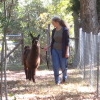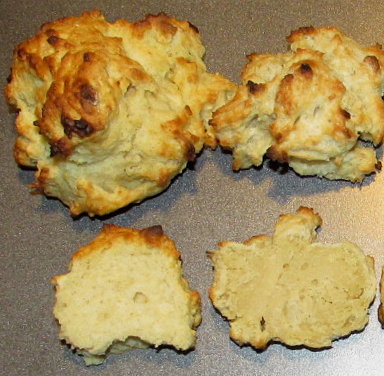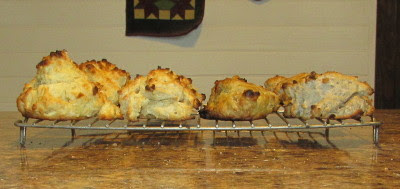

| Online: | |
| Visits: | |
| Stories: |

| Story Views | |
| Now: | |
| Last Hour: | |
| Last 24 Hours: | |
| Total: | |
Baking With Wood Ash? (Part 3: The Results!)
When my ash water/vinegar experiments were a bust (see Part 2), I felt like I was at a crossroads. I could continue researching the chemistry of the process, or I could get on with my baking experiments. I opted to do some baking!
In preparing the ash water for baking I made a few changes from the way I did my test batches. This time I increased the amount of ashes to make a 1:1 solution of equal parts hardwood ashes and water. Also, I followed Farmer Liz's and Jake's suggestions to use hot water. According to The Caveman Chemist, hot water should extract about 225% more potassium carbonate from the ashes (which is what causes the leavening action by reacting with the acid to make carbon dioxide bubbles). I let the solution sit overnight and then strained out the ashes the following morning.
For the baking part of my experiment I decided to make drop biscuits. I used one of my standard recipes but quartered the amounts. My base recipe was
- 1/2 cup flour
- 1/8 tsp salt
- 1/8 cup (2 tbsp) palm shortening
- 1/4 cup (4 tbsp) milk
- 1/2 tsp vinegar
- 1/4 tsp baking soda
I used white flour and white vinegar in all the recipes, I only changed the baking soda in my experimental samples (details below). I made four batches with four biscuits each and baked them in my toaster oven at 425°F (218°C) for 8-10 minutes. Here's how they looked after baking.
 |
| Samples #1-4 – top (above) and side view (below) |
Next I broke a sample of each biscuit open.
 |
| They are in the same order as the above caption. |
Obviously the baking soda and vinegar biscuit on the left rose the best. #2 (2nd from left) with 2 tbsp ash water rose well, but 4 tbsp (#3) less so. The same was true for the dry ash (#4 on the right), however, they both still rose! Since I added more ash water to batch #3, I might have suspected a higher rise. What I think is that it would have benefited from more acid (vinegar) and I would have gotten a better rise. Ditto for the dry ash biscuit on the left – more vinegar to make more carbon dioxide bubbles. If I were to continue experimenting, that would be my next step.
When they were cool, I sliced them open. This gives us a better idea of texture and color.
 |
| Left: baking soda biscuit. Right: #2, the 2 tbsp ash water biscuit. |
 |
| Left: #3, the 4 tbsp ash water biscuit. Right: #4, the dry wood ash biscuit. |
One thing I noticed immediately was that all three batches with wood ash were not completely dry inside. In other words, they could have baked a little longer.
Color? I expected the dry ash biscuit to be more grayish than it turned out, but I don't find the color objectionable at all. What do you think?
How did they taste? [Drumroll................] They tasted like biscuits. No odd flavor or bitter or soapy aftertaste, which apparently is a problem when baking with pearlash (which is more concentrated because it is purified and refined). Batch #3, in which the milk was replaced with ash water, actually had a pretzel flavor. Pretzels are dipped in lye water before baking to give them their characteristic shiny pretzel brown (known as the Maillard reaction), but apparently the lye water adds a characteristic pretzel flavor as well. If you take a second look at the photo of #3 above, you can see that the surface of that biscuit is somewhat shiny like a pretzel.
My next test was to have Dan try them. He liked them too!
So, back to the original question. Can hard wood ash be used in place of baking soda for baking quick breads? Absolutely. The ash water method took a little advance preparation and had less impact of biscuit color, but in a pinch hardwood ash could be used too, although I would recommend a very fine sieve to prevent random grittiness.
Anyone game? If you do try making your own ash water, keep in mind that results can vary because the chemical composition of hardwood ash varies according to wood type and burning temperature. I would recommend a small test baking with each new batch of hardwood ash.
Lastly, here are links for part of my bibliography plus some other related stuff:
- An Experiment with Period & Non-Period Leaveners
- A Comparison of Leavening Agents (PDF)
- The History Dish: Pearlash, The First Chemical Leavening
- American Potash Cake or Long Island Pound Cake: Historical Food Fortnightly: Challenge 7
- Potash and Pearlash – German Baking Aid - there's an interesting comment here about increasing the acid in the recipe to counteract the soapy aftertaste of pearlash
- How to make your own potash. Scroll down to “Instructions” at the bottom of the page.
- Maillard Reaction
- Wood Ash Composition as a Function of Furnace Temperature (PDF)
Source: http://www.5acresandadream.com/2016/01/baking-with-wood-ash-part-3-results.html



